
Gateway cities, parks must work together
What do Gatlinburg, Tenn., Gardiner, Mont., Tuscayan, Ariz. and Mariposa, Calif., have in common?
They are gateway communities to the four most-visited national parks that contributed to the $10.7 billion spent by visitors in 2006, according to the most recent National Park Visitor Spending and Payroll Impacts study conducted by Daniel Stynes, professor emeritus of community, agriculture, recreation and resource studies at Michigan State University.
Among those visitors, more than half spent their money on lodging and restaurants.
| Communities near parks are scattered with businesses (Photo courtesy of the National Park Service). | 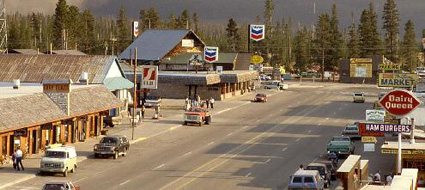 |
“We survived because of them,” said Tom Dickson, director of Engineering and Maintenance of the Best Western Grand Canyon Squire Inn in Northern Arizona. “After 9/11, tourism took a downfall both air wise and on the road.”
Nancy Gray, park ranger and spokesperson at Great Smoky Mountains National Park in Tennessee and North Carolina said that visitors coming to the park stimulate revenue for outlaying communities.
“Visitors rely on these gateways for services that the park cannot offer,” said Gray. “Services such as filling up for gas, meals at restaurants and places to stay overnight are provided year-round in nearby communities.”
Marysue Costello, executive director of West Yellowstone Chamber of Commerce, said that as part of the established relationship parks share with gateway communities on bringing in more visitors, gateway communities also offer park visitors choices to just visiting the parks and vice versa.
Many visitors, especially those with children, turn to gateway communities as alternative forms of entertainment mentioned Dickson.
When the sun sets on the Grand Canyon and stars begin to scatter the sky, Kathy and Jim Harrison, annual visitors to the park are left with a fidgety five-year-old and a squirmy seven-year-old along with the looming thought: What are we going to do to keep these kids occupied?
| A fireman putting out the flames that almost engulfed one of the many businesses located in West Yellowstone (Photo courtesy of the National Park Service). | 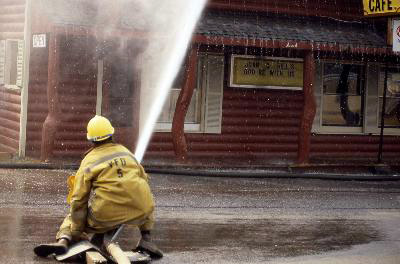 |
The Best Western Grand Canyon Squire Inn, located in Tusayan, Ariz., is Grand Canyon’s only full-service resort, offering an impressive assortment of amenities. For visitors with children or those young at heart, the hotel offers a six lane bowling alley, an arcade and billiards. Just up the street is an IMAX Theater repetitively showing a movie about the Grand Canyon.
“While we can finally kick up our feet and relax at the end of the day, the kids can keep busy with stuff they usually do at home,” said Kathy Harrison.
Costello said that for other parks like Yellowstone, lodging is not easy to come by within the park. Therefore, the gateway community of West Yellowstone offers plenty of lodging year-round where average visitor stay is 2½ nights.
“By far, visitation drives these communities,” Costello said. “The only reason gateway communities are here are for the parks.”
Gray said that the year-round services of the neighboring communities have made visitation increase in months considered off-season at the Great Smoky Mountains.
| A sign says farewell to visitors leaving Yellowstone National Park, however a gas station and stores welcome them to West Yellowstone (Photo courtesy of the National Park Service). | 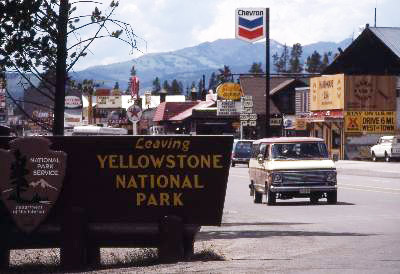 |
“Gateways bring their own visitors, but still share a wonderful relationship with the park,” said Gray. “Using the park, they draw in interested visitors and the park is always appealing to those who initially come to visit one of the nearby communities.”
The decline of the dollar attracted masses of foreign visitors to parks and gateway communities.
Both the Grand Canyon and Yosemite claim more than half of their visitors last year were from another country.
|
Most Visited National Parks (2007) |
| Park Unit Recreational Visits |
|
1. Great Smoky Mountains NP 9,372,253 |
|
2. Grand Canyon NP 4,413,668 |
|
3. Yosemite NP 3,503,428 |
|
4. Yellowstone NP 3,151,343 |
|
“On a regular Wednesday afternoon, we can expect to see about 750 people,” said Dickson. “Of that, 60 percent are international guests.”
Other gateway communities like West Yellowstone, that do not get a large population of international visitors, are still recognizing a different group of Yellowstone park-goers.
“We’re getting visitors nationally rather than just in-state,” said Costello.
Economic studies have also shown that visitor spending supports about 213,000 jobs in gateway regions. Aside from housing these employees, gateway communities house many park employees as well.
However, for park employees living in rural gateway communities, getting to or from work poses as a problem. Filled with fatigue as they leave for work early in the morning or drive home after a long day’s work at the park, some must travel over 50 miles, risking their lives and others while on the road. Therefore, many parks offer alternative transportation methods that benefit both employees and visitors.
Dickson mentioned a new shuttle route that will begin next month by Paul Revere Transportation circulating every 20 minutes from Gardiner to the northern entrance of the Grand Canyon.
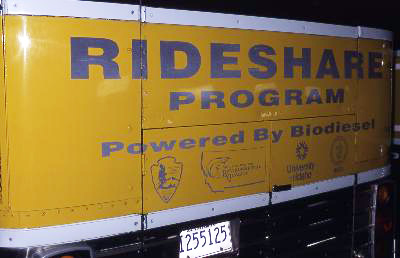 |
The back of one of three biodiesel buses Yellowstone National Park uses for its Rideshare Program (Photo courtesy of the National Park Service). |
“A lot of employees don’t have private vehicles and up to now, have been using local taxis as a way of transportation,” said Dickson. “Visitors won’t be the only ones taking advantage of this.”
Linda Miller, spokesperson for the superintendent’s office at Yellowstone National Park, said that she considers the Rideshare Program successful for numerous reasons.
“Savings from less fuel consumption, greater safety, reduced traffic and air pollution and fewer parking constraints, just to name a few,” said Miller. “It takes a lot of risk out of the equation.”
Willie Burkhardt, an electrician and administrator of Yellowstone’s Rideshare program, said the program has lessened in-park housing because it allows employees the opportunity to live in more affordable housing in gateway communities.
“When you work in the park a majority of the week, it’s nice to be able to get away at the end of the day,” said Burkhardt.
Burkhardt also mentioned that every day, about 40 employees pay up to $4 (depending on the distance they travel) to commute using the three biodiesel buses.
Leroy Redonavich, tourism director at Yosemite National Park, said that in Yosemite, where private vehicles are more commonly found, the Yosemite Area Transportation System (YARTS) is still used by a majority of tourists in neighboring communities and employees of the park.
“I really believe people use this as a choice rather than a necessity,” said Redonavich. “Though they have the convenience of owning their own cars, this alternative system provides them with the convenience of not having to worry about parking, using up gas or polluting the air.”
| A YARTS bus transporting passengers in Yosemite National Park (Photo courtesy of Dick Whittington, YARTS). |
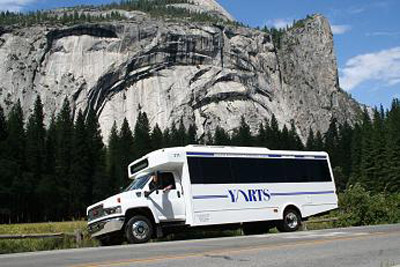 |
Many gateway communities and parks also share partnerships where they work in cooperation on issues affecting both the community and the park.
“When we look at park planning for the next 20 years, we keep these communities in mind,” said Adrienne Freeman, public affairs officer at Yosemite National Park.
Redonavich said that he meets with the town of Mariposa on a quarterly basis to discuss issues ranging from advertising to transportation.
Gray said that she works close with local schools to use Great Smoky Mountains National Park as a classroom for children.
“Education is important not just for visitors but for our neighbors because they help manage the park,” said Gray. “Kids need to know about maintaining and preserving the park’s resources because it will most likely be part of their future.”
When problems strike the park’s facilities, many park officials and visitors turn to gateway communities for refuge.
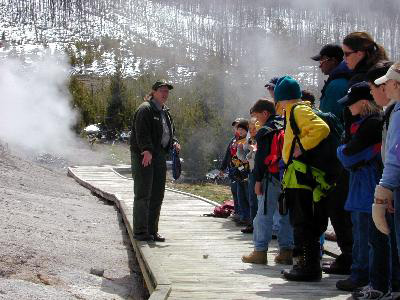 |
Heidi Doss, ranger at Yellowstone National Park, talks to visitors at the Norris Geyser Basin (Photo courtesy of the National Park Service). |
Redonavich said that when the 1997 flood destroyed a majority of Yosemite’s campgrounds, many visitors stayed among the 360 hotel rooms in the gateway community of Mariposa.
Freeman feels that the perception of making a reservation six months in advance has change because gateways allow people to get last-minute lodging. She also said that the park and gateway communities share a mutual aid pact.
“We heavily rely on them, especially during emergency situations,” said Freeman. “If anything was to go wrong such as a road being closed off or someone gets injured, you know that help is just a town away.”
|
Gateway Communities of the Most Visited Parks (2007) |
|
|
Park |
Populations of Major Gateway Communities |
|
1. Great Smoky Mountains NP |
Whittier, NC (6,000) |
|
2. Grand Canyon NP |
Grand Canyon, AZ (1,412) |
|
3. Yosemite NP |
Oakhurst, CA (3,251) |
|
4. Yellowstone NP |
West Yellowstone, MT (1,232) |
|
|

Comments are Closed